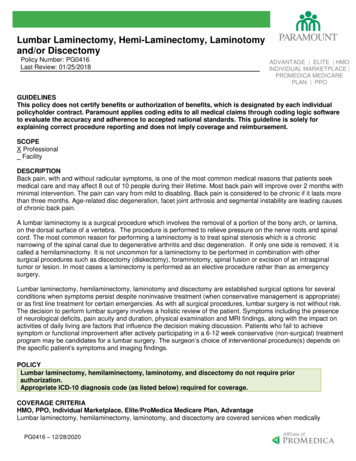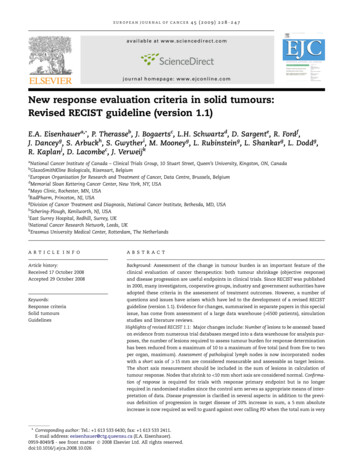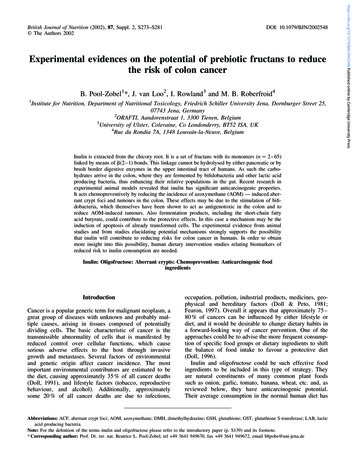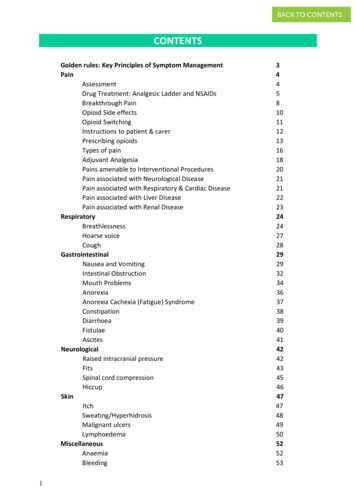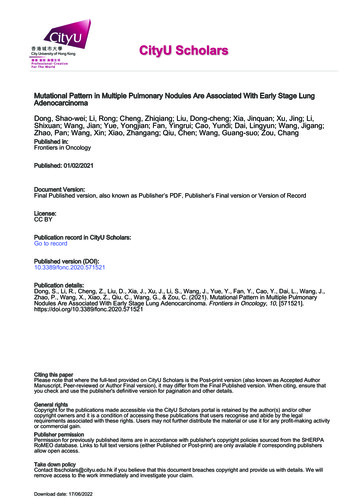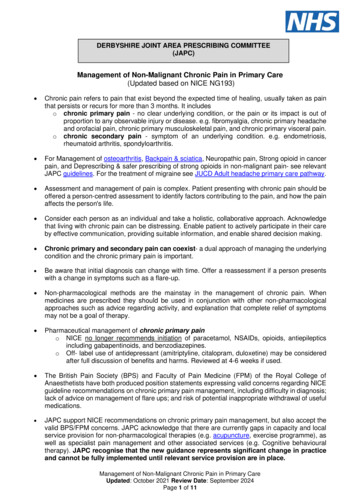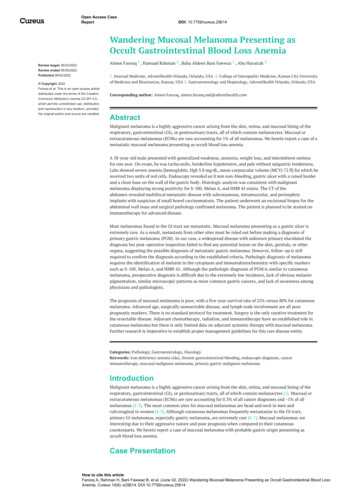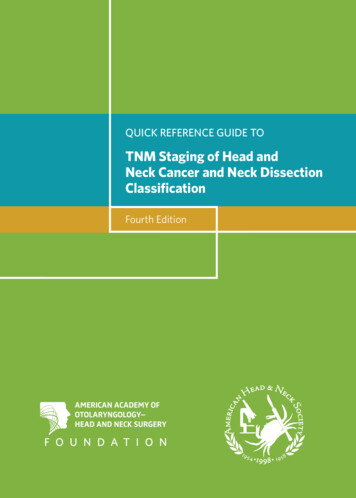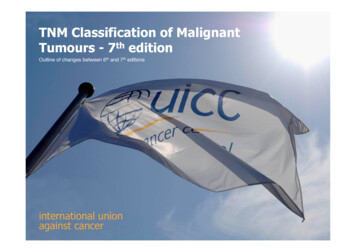
Transcription
TNM Classification of MalignantTumours - 7th editionOutline of changes between 6th and 7th editionsinternational unionagainst cancer
TNM 7th edition available now!The aim of this presentation is to: present the changes between the6th and 7th edition Indicate where no changes have takenplace provide links to where questions on theuse of TNM may be found
Special thanks to the editorsDr Mary GospodarowiczDr Christian WittekindDr Leslie Sobin
Highlights Changes to take effect from January 2010 The rules of classification and staging correspond to those appearing in theseventh edition of the AJCC Cancer Staging Manual 2009 and have approval ofall national TNM committees First time the UICC process for evaluating proposals has been used
Highlights 9 new classifications 6 major modifications Elimination of MX Introduction of Anatomical Stage Grouping andPrognostic Grouping
First time the UICC process forevaluating proposals has beenusedA continuous systematic approach composed of two arms has been introduced: procedures to address formal proposals from investigators periodic literature search for articles about improvements to TNMProposals and results of the literature search are evaluated by members of a UICCpanel of experts, the TNM Prognostic Factors committee, the AJCC and the othernational TNM expertsThe changes to Lung cancer staging proposed by the IALSC and adopted are anexample of this process
TNM-7 New classifications Melanoma of upper aerodigestive tractGastroesophageal carcinomasGastrointestinal stromal tumours (GISTs)Appendix: carcinomasNeuroendocrine tumours:stomach, intestines, appendix; pancreas; lungIntrahepatic cholangiocarcinomaMerkel cell carcinomaUterine sarcomasAdrenal cortex
TNM-7 Major modifications EsophagusStomachLungSkinVulvaProstate
TNM-7 Minor or no modifications Head and neckSmall intestineColonAnal canalLiver, hepatocellularGallbladder, ampulla, pancreasMesothelioma, pleuralSkin, melanomaGynecological sites: except vulvaUrological sites: except prostate
Elimination of MXThe use of MX may result in exclusion from stagingcMX is inappropriate as the clinical assessment of metastasis canbe based on physical examination alone.If the pathologist does not have knowledge of the clinical M, MXshould NOT be recorded. It has been deleted from TNM.pMX: does not exist; pM0: does not exist (except at autopsy)
Elimination of MXWhat remains:cM0 clinically no distant metastasiscM1 distant metastasis clinically, e.g., colon cancerwith liver metastasis based on CTpM1 distant metastasis proven microscopically, e.g.,needle biopsyIf a cM1 (e.g., liver met) is biopsied and is negative, itbecomes cM0, not pM0
Stage Grouping andPrognostic GroupingStage grouping: Anatomical extent of disease, composed of T, N,and M categories alonePrognostic Grouping: T, N, and M plus other prognostic factorsFor most tumour sites only the (Anatomical) Stage Grouping isgiven
Nasopharynx – 7th editionT1 Nasopharynx, oropharynx or nasalcavity (was T2a) without parapharyngealextensionT2 Parapharyngeal extension (was T2b)T3 Bony structures of skull base and/orparanasal sinusesT4 Intracranial, cranial nerves,hypopharynx, orbit, infratemporal fossa/masticator spaceN1 Unilateral cervical, unilateral orbilateral retropharyngeal lymph nodes,above supraclavicular fossa; 6 cmN2 Bilateral cervical above supraclavicularfossa; 6 cmN3a 6 cm; N3b Supraclavicular fossaAnatomical Stage GroupsStage IStage IIStage IIIStage IVAStage IVBStage IVCM1T1T1T2T1, T2T3T4Any TAny TStage II compressed Changes from TNM 6N0N1N0, N1N2N0, 1, 2N0, 1, 2N3Any N
Mucosal Melanoma (upperaerodigestive) 7th ed - (new site)T3 Epithelium/ submucosa (mucosaldisease)T4a Deep soft tissue, cartilage, bone,oroverlying skinT4b Brain, dura, skull base, lowercranialnerves, masticator space, carotidartery, prevertebral space,mediastinal structures, cartilage,skeletal muscle, or boneSTAGE GROUPINGStage IIIStage IVAT3T4aT3-T4aN0N0N1Stage IVBStage IVCM1T4bAny TAny NAny NMucosal melanomas are aggressivetumours, therefore T1 and T2 andStages I and II are omitted
TNM-7Oesophagogastric junction tumoursA tumour the epicenter of which is within 5 cm of theesophagogastric junction and also extends into the oesophagus isclassified and staged according to the oesophageal schemeAll other tumours with an epicenter in the stomach greater than 5cm from the oesophagogastric junction or those within 5 cm of theEGJ without extension into the oesophagus are staged using thegastric carcinoma scheme
Oesophagus 7th editionTNM definitions: AJCC UICCTisT1T2T3T4Carcinoma in situ /High-gradedysplasialamina propria or submucosaT1a lamina propria or muscularismucosaeT1b submucosamuscularis propriaadventitiaadjacent structuresT4a pleura, pericardium,diaphragm, or adjacentperitoneumT4b other adjacent structures,e.g. aorta, vertebral body,tracheaN0No regional lymph nodemetastasisN11 to 2 regional lymph nodesN23 to 6N3 6[N1 was site dependent]M - Distant MetastasisM1Distant metastasis[M1a,b were site dependent]Changes from 6th edition
Oesophagus 7th editionAnatomical Stage Groups (adeno & squamous) [UICC]Stage IAStage IBStage IIAStage IIBStage IIIAStage IIIBStage IIICStage IVT1T2T3T1, T2T4aT3T1, T2T3T4aT4bAny TAny TN0N0N0N1N0N1N2N2N1, N2Any NN3Any NM0M0M0M0M0M0M0M0M0M0M0M1Major changes
Oesophageal Squamous Cell CarcinomaPrognostic Grouping[AJCC adds type, grade & site]TStage IA1IB12, 3Stage IIA2, 32, 3Stage IIB2, 31, 2Stage IIIA1,234aLow Stages: AJCC not all er01,XUpper, middle02,3Lower02,3Upper, middle0AnyAny20Any0AnyAny0AnyAnyStages IIIA,B, C & IV: AJCC UICC
Oesophageal AdenocarcinomaPrognostic Grouping[AJCC adds type & grade]Stage IAStage IBStage IIAStage IIBStage IIIAT11223 (IIA)1, 21, 234aStage IIIB, IIIC, & IV Low Stages: AJCC not all UICC.AJCC UICCN000001210M000000000Grade1, 2, X31, 2, X3AnyAnyAnyAnyAnyStages IIIB, C & IV:
Stomach 7th editionT1 Lamina propria, submucosaT1a Lamina propriaT1b SubmucosaT2 Muscularis propriaT3 Subserosa (was T2b)T4a Perforates serosa (was T3)T4b Adjacent structuresN1N2N3aN3b1 to 2 nodes3 to 6 nodes (was N1)7 - 15 nodes (was N2)16 or more (was N3)Changes from 6th editionStage IAStage IBStage IIAStage IIBStage N1N2T2N3Stages IIIB, IIIC, IV.Stages: most changed
Gastrointestinal Stromal Tumours (GIST)7th ed -All sites:T1 2 cm T3 5-10 cmT2 2 – 5 cmT4 10new chapterPrognostic factors: site, size,mitotic ratecmStage Grouping - StomachStageGrouping - Small IntestineMitotic rateStage IT1-2 N0 M0LowStage IIT3LowStage IIIA T1HighT4Stage IIIB T2, 3, 4Stage IV Any T N1 M0Any T Any N M1LowHighAnyAnyMitoticrateStage IA T1-2N0 M0Stage 1B T3Stage IIT-2T4Stage IIIA T3IIIB T4Stage IV Any TN1 M0Any T Any N M1LowLowHighLowHighHighAnyAny
Carcinoids andNeuroendocrine tumoursStagingGI tract: Carcinoid : separate staging by site Small cell/large cell: stage as carcinomaPancreas: stage as carcinomaLung: stage as carcinomaSkin: separate classification for Merkel cell carcinoma
Carcinoids (NET) – 7th editionGastrointestinalAppendixT1 2 cmT2 2 – 4 cm; cecumT3 4 cm; ileumT4 Perforates peritoneum; other organs,structuresSmall IntestineT1 Lam propria/ submucosa and 1 cmT2 Muscularis propria or 1 cmT3 Jejunal, ileal: subserosa.Ampullary, duodenal: pancreas orretroperitoneum T4 Perforates serosa; adjacent structuresStomachTis 0.5 mm confined to mucosaT1 Lam propria or submucosa & 1cmT2 Muscularis propria or 1 cmT3 SubserosaT4 Perforates serosa; adjacent structuresLarge IntestineT1 Lam propria or submucosa or 2cmT1a 1 cm; T1b 1 to 2 cmT2 Muscularis propria or 2 cmT3 Subserosa, or pericolorectal tissuesT4 Perforates serosa; adjacent structures
Carcinoids (NET) – 7th editionStage GroupsCarcinoid: other GI sitesCarcinoid: AppendixStage IStage IIStage IIIT1T2, T3T4Any TStage IV Any T Any NStage IStage IIAIIBStage IIIAIIIBStage IVN0N0N0N1M1VerysimilarT1T2T3T4Any TAny TN0N0N0N0N1Any N M1
Appendix– 7th editionCarcinoidCarcinomaT1T2T3T4 2 cm 2 – 4 cm; cecum 4 cm; ileumPerforates peritoneum; other organs,structuresN1 RegionalStage IStage IIStage IIIT1T2, T3T4Any TStage IV Any TN0N0N0N1Any NBased mainly on sizeM1T1 SubmucosaT2 Muscularis propriaT3 Subserosa, non-peritonealizeperiappendiceal tissuesT4a Perforates visceralperitoneum/Mucinous peritoneal tumourwithin right lower quadrantT4b Other organs or structuresN1 3 regionalN2 3 regionalM1a Intraperitoneal metastasis beyond rightlower quadrantM1b Non-peritoneal metastasisLike colon, based on depth; includes gobletcell carcinoid
Appendix– 7th editionCarcinoma (was part of colon classification)Colon - RectumT4Tumour directly invades otherorgans or structures and/orperforates visceral peritoneumT4aperforates visceral peritoneumT4bdirectly invades other organ orstructuresM – Distant Metastasis: colonM1Distant metastasisM1aone organM1b one organ or peritoneumChanges from TNM 6Appendix - Carcinoma: Separatemucinous from nonmucinouscarcinomasT4a Perforates visceralperitoneum/Mucinous peritonealtumour within right lower quadrantT4b Other organs or structuresM1a Intraperitoneal metastasis beyondRLQM1b Non-peritoneal metastasisChanges from colon
Colon - Rectum – 7th editionT4Tumour directly invades other organsor structures and/or perforatesvisceral peritoneumT4a perforates visceral peritoneumT4b directly invades other organ orstructuresM1 Distant metastasisM1a one organM1b one organ or peritoneumMetastasis in 1 to 3 regional lymphnodesN1a 1 nodeN1b 2 – 3 nodesN1c satellites in subserosa, withoutregional nodes*N2Metastasis in 4 or more regionallymph nodesN2a 4 – 6 nodesN2b 7 or more nodesBasic categories unchangedSubdivisions expandedBasic categories unchangedSubdivisions expandedN1Changes from 6th edition
Colon - Rectum – 7th editionStage 0Stage ITisT1, T2N0N0Stage IIStage IIAT3, T4N0T3Stage IIIStage IIIAStage IIIBN0Stage IIBT4aN0Stage IICStage IIICT4bN0Basic categories unchangedSubdivisions expandedStage IVStage IVAChanges from TNM 6Stage IVBAny TN1-2T1, T2T1N2aT3, T4aT2-T3N2aT1-T2N2bT4aN2aT3-T4aN2bT4bN1-2Any TM1Any TM1aAny TM1bN1N1Any NAny NAny N
Extrahepatic bile ducts 7th edProximal bile duct (New site)(right, left and common hepatic ducts)T1 Ductal wallT2a Beyond ductal wallT2b Adjacent hepatic parenchymaT3 Unilateral portal vein or hepatic arterybranchesT4 Main portal vein or branches bilaterally; N1 RegionalSTAGE GROUPS (Proximal)Stage IT1N0Stage IIT2a-bN0Stage IIIA T3N0Stage IIIB T1-3N1Stage IVA T4Any NStage IVB Any TAny NM1Distal Extrahepatic Bile Ducts(from cystic duct insertion into commonhepatic duct)T1 Ductal wallT2 Beyond ductal wallT3 adjacent organsT4 Celiac axis, or superior mesenteric arteryN1 RegionalSTAGE GROUPS (Distal)Stage IA T1N0Stage IB T2N0Stage IIA T3N0Stage IIB T1 – 3N1Stage III T4Any NStage IV Any TAny NM1No change
Lung – 7th editionincludes non-small cell and small cell carcinoma & carcinoidT1 3 cmT1a 2 cmT1b 2 – 3 cmT2 Main bronchus 2 cm from carina,invades visceral pleura, partial atelectasisT2a 3- 5 cmT2b 5 cm -7 cmT3 7 cm; chest wall, diaphragm,pericardium, mediastinal pleura, mainbronchus 2 cm from carina, totalatelectasis, separate nodule(s) in samelobe (was T4)T4 Mediastinum, heart, great vessels,carina, trachea, oesophagus, vertebra;separate tumour nodule(s) in adifferent ipsilateral lobe (was M1)N1 Ipsilateral peribronchial, ipsilateralhilarN2 Ipsilateral mediastinal, subcarinalN3 Contralateral mediastinal or hilar,scalene or supraclavicularM1a Separate tumour nodule(s) in acontralateral lobe; pleural nodules ormalignant pleural or pericardialeffusion (was T4)M1b Distant metastasisChanges from 6th edition
Lung – 7th editionincludes non-small cell and small cell carcinoma & carcinoidOccult carcinoma TXN0Stage 0TisN0Stage IAT1a, bN0Stage IBT2aN0Stage IIAT2bN0N1T2aStage IIBT2bN1T3N0Stage IIIA T1a,b, T2a,bT3T4Stage IIIB T4Any TStage IV Any TAny NT1a, bN1N2N1, N2N0, N1N2N3M1Changes to the 6th edition are based uponrecommendations from the IASLC LungCancer Staging Project (retrospectivestudy of 80,000 cases)One classification for several tumor types;must separate tumors by histology.Changes from 6th edition
Skin 7th ed - carcinomas6th edT1 2 cmT2 2 to 5 cmT3 5 cmT4Deep extradermal structures(bone, muscle )7th edT1 2 cmT2 2 cmT3 Deep: Muscle, bone, cartilage, jaws,orbitT4 Skull base, axial skeletonN1N1 single 3 cmN2 single 3 to 6 cm, multiple 6 cmN3 6 cmRegional
Skin 7th ed - carcinomas6th edStage IStage IIStage IIIT1N0T2, T3 N0T4 orN1Stage IV Any TAny -----High Risk Factors (AJCC) 4 mm thickness, Clark IVPerineural invasionLymphovascular invasionEar, non-glabrous lipPoorly or undifferentiated*Stage I with one high risk factor Stage II Anatomical Stage GroupsStage IT1N0Stage IIT2N0Stage IIIT3N0T1, 2, 3 N1Stage IV T1, 2, 3 N2T4 or N3 or M1AJCC Prognostic GroupsStage I * T1N0Stage IIT2N0Stage III and IV: Same as anatomicalabove
Skin 7th editionSkin Carcinoma7th edT1 2 cmT2 2 cmT3 Deep: Muscle, bone, cartilage, jaws,orbitT4 Skull base, axial skeletonN1 single 3 cmN2 single 3 to 6 cm, multiple 6 cmN3 6 cmMerkel Cell carcinomaMerkel cellT1 2 cmT2 2 to 5 cmT3 5 cmT4 Deep extradermal structures (bone,muscle )N1a microscopic metastasisN1b macroscopic metastasisN2 In transit metastasisM1a skin, subcut, non-regional nodesM1b lungM1c other sitesDiffers from other skin carcinoma
Skin 7th editionSkin CarcinomaMerkel cellcarcinomaMerkel cell carcinomaStage IStage IIStage IIIT1T2T3T1, 2, 3Stage IV T1, 2, 3T4 orN0N0N0N1N2N3 or M1pN0 microscopically confirmedcN0 nodes neg. clinically; not microconfirmedStage IIAIBT1T1cN0N0pN0Stage IIAIIBIICT2, 3T2, 3T4pN0cN0N0Stage IIIAIIIBAny TAny TN1aN1b, N2Stage IV Any TAny NM1T1
Vulva– 7th edT1T1aT1bT2T3N1aConfined to vulva/perineum 2 cm with stromal invasion 1.0 mm 2 cm or stromal invasion 1.0 mmLower urethra/vagina/anusUpper urethra/vagina, bladderrectal/mucosa, bone, fixed to pelvic boneOne or two nodes 5 mmN1bOne node 5 mmN2a3 or more nodes 5 mmN2b2 or more nodes 5 mmN2cExtracapsular spreadN3Fixed, ulceratedM1DistantMajor changes in T & N categories and stage groupingSTAGE GROUPINGStage 0TisStage IT1Stage IA T1aStage IB T1bStage IIT2Stage IIIA T1, T2Stage IIIB T1, T2Stage IIIC T1, T2Stage IVA T1, T2M0Stage IVB Any TN0N0N0N0N0N1a, N1bN2a, N2bN2cN3T3M0M0M0M0M0M0M0M0M0Any NAny NM1
Uterine SarcomasLeiomyosarcoma/Endometrial stromalsarcomaITumor limited to uterusIA 5 cmIB 5 cmIIBeyond uterus, in pelvisIIAAdnexalIIBOther pelvic tissuesIIITumor invades abdominal tissuesIIIAOne siteIIIB one siteIIICPelvic/para-aortic nodesIVATumor invadesbladder/rectumIVBDistant metastasisCarcinosarcoma staged as endometrialcarcinoma– 7th edAdenosarcomaITumor limited to uterusIAEndometrium/endocervixIB half myometriumIC half myometriumIIBeyond uterus, in pelvisIIAAdnexalIIBOther pelvic tissuesIIITumor invades abdominal tissuesIIIAOne siteIIIB one siteIIICPelvic/para-aortic nodes IVAInvades bladder/rectumIVBDistant metastasis
Prostate- 7th editionT1 Not palpable or visibleT1a 5% or lessT1b 5%T1cDetected by needle biopsyT2 Confined within prostateT2a half of one lobeT2b half of one lobeT2cBoth lobesT3 Through prostate capsuleT3aExtracapsularT3bSeminal vesicle(s)T4 Fixed or invades adjacent structuresNo change from 6thSTAGE GROUPING (ANATOMIC)(UICC)StageStageStageStageIIIIIIIVT1, T2aT2b-2cT3T4Any TAny TN0N0N0N0N1Any NM1Change from 6thGrade was in 6th
Prostate- 7th edPROGNOSTIC GROUPINGIT1a – cT2aN0N0PSA 10PSA 10Gle 6Gle 6IIAT1 a – cT1 a – cT2a,bN0N0N0PSA 20Gle 7PSA 10 20 Gle 6PSA 10 20 Gle 7If PSA or Gleason is missing, use whatever is availableIIBIIIIVT2cN0T 1-2 N0T 1-2 N0T3a-c N0T4N0Any T N1Any T Any NAny PSA Any GlePSA 20 Any GleAny PSA Gle 8Any PSA Any GleAny PSA Any GleAny PSAAny GleM1 Any PSA Any GleIf both missing, no prognostic grouping is possible
Adrenal Cortical Carcinoma - 7thedition(new site)STAGE GROUPINGT1T2T3T4 5 cm, no extra-adrenal invasion 5 cm, no extra-adrenal invasionLocal invasionAdjacent organsN1 RegionalM1 DistantStage IStage IIStage IIIT1T2T1, T2T3Stage IV T3T4Any TN0N0N1N0N1Any NAny NM1
What else is new?PnPerineural InvasionPnXPn0Pn1Perineural invasion cannot beassessedNo perineural invasionPerineural invasion
What else is new?Tumour deposit or satellite in colorectal cancer N1cTumour deposit(s), i.e. satellites, in the subserosa, or in nonperitonealized pericolic or perirectal soft tissue withoutregional lymph node metastasis If a nodule is considered by the pathologist to be a totallyreplaced lymph node (generally having a smooth contour), itshould be recorded as a positive lymph node and counted assuch i.e., N1a,N1b, N2a or N2b
Additional Materialwww.uicc.org/tnm Web page FAQ: Answers to frequently asked questions about TNM Helpdesk for questions on TNM not answered by the FAQ Guidelines on how to use TNM Glossary of terms used How to propose changes for the 8th edition
Translations of 7th editionplanned
Coming Soon4th edition:6th edition:On schedulefor Dec 2009submissionOn schedulefor 2010submission4th edition:Combined publicationwith UICC Manual ofClinical Oncologyplanned
international unionagainst cancer
A continuous systematic approach composed of two arms has been introduced: procedures to address formal proposals from investigators periodic literature search for articles about improvements to TNM

